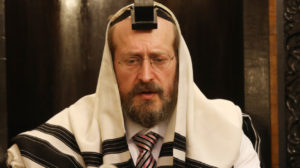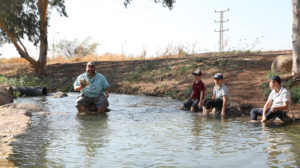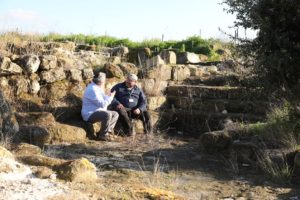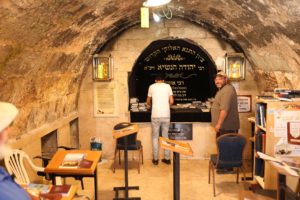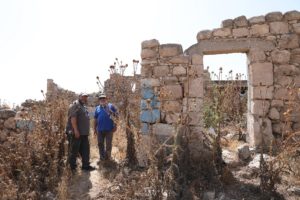Home on the Range

When people ask a heimish guy like Refoel Franklin what he’s doing on a farm in upstate New York, he doesn’t even get the question. “Why would anyone want to live in the city, when you can be out here in G-d’s country?”
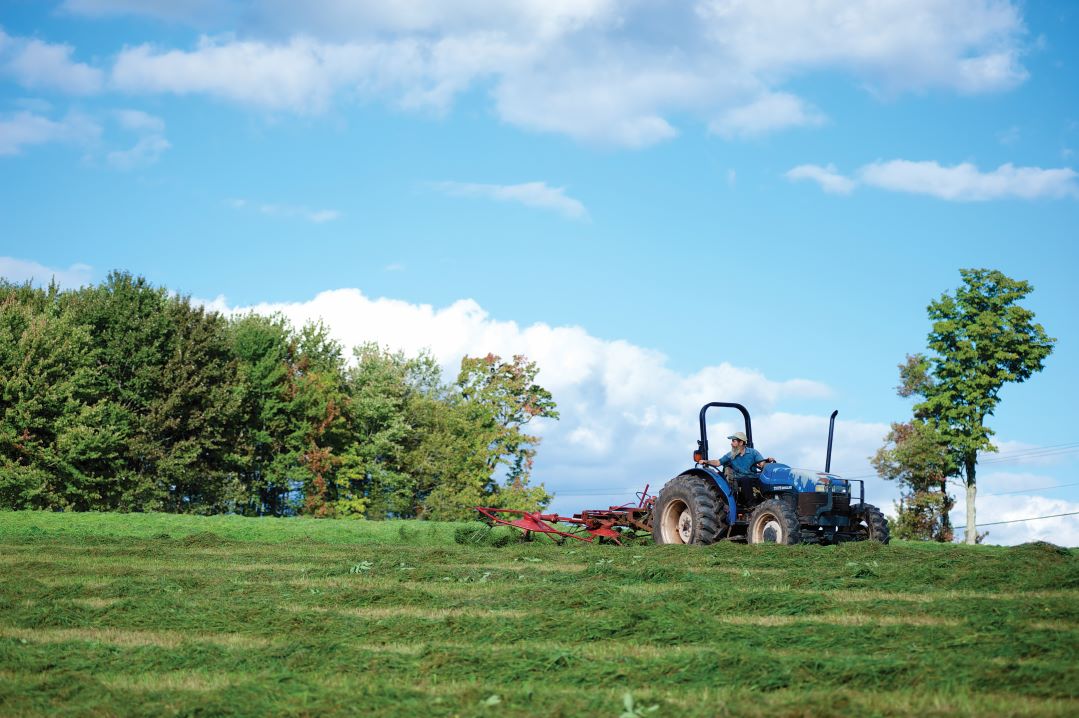
Photos Meir Haltovsky, Family Archives
When people ask a heimish guy like Refoel Franklin what he’s doing on a farm in upstate New York, he doesn’t even get the question. “Why would anyone want to live in the city, when you can be out here in G-d’s country?” he asks in wonder. But it’s not like he’s living in isolation (although he did once spend a year living alone in a log cabin in the Montana hills):
His slaughterhouse and dairy farm produce the only chicken and milk products some rebbes will eat
I motored many a mile through the rolling farmlands of Bethel, New York,just a half-mile from Woodstock (which supposedly defined a generation, but is now an answer to a trivia question) in search of the Franklin farmstead and home of Pelleh Poultry. Bearing left onto Happy Avenue (no kidding!) I arrive at number 522 to find Refoel Franklin — the man whose slaughterhouse and farm produce the only chicken and milk products some rebbes will eat. Decked out in work clothes, his face framed by a cap and long beard, he’s hard at work sharpening a chain saw on the back of his pickup truck.
My first question is the most obvious one, considering how long it took to get out here: “What are you doing here?” Refoel turns the question right around, asking “Where do you live?” When I reply, “Far Rockaway,” Refoel doesn’t miss a beat: “So what are you doing there? You know, we give tours, sometimes for heimishe chevreh in Yiddish. I tell them about the soil, about why we spread manure, we give milking demonstrations, we explain what we do here.
“So this chassidishe Yid from Williamsburg enjoyed the tour very much, but when it was over he said to me, ‘Ich farshtai nisht ein zach. Farvus hut ihr oisgevelt aza mudneh parnussah [There’s one thing I don’t understand, why did you choose such a strange livelihood?]’ I asked him in Yiddish, ‘And what do you do?’ He says he’s a building manager in the Bronx. I said, ‘I chose a strange livelihood? You go around in the Bronx among half-dressed goyim and filthy air, and I’m out here with the Creator’s wonders of nature. What’s so strange?’ All he could say was, ‘You’re right, but that’s where I make my living.’ So I said, ‘Nu, and I make my living here.’ ”
Refoel’s chassidish-inflected Yiddish is natural and rich, not what one expects from someone who grew up nonobservant and for decades
shared the Montana wilds with moose and grizzlies. But in the person of Refoel Franklin, polar opposites like Yiddish and the American West merge rather than clash. Like his great rebbi, Rav Shlomo Freifeld, the late yet unforgettable rosh yeshivah of Sh’or Yoshuv, Refoel takes the broad view on things, in which everything finds its appropriate place in the panorama of life.
Well, almost everything. Refoel can’t make peace with the idea of living anywhere near the city. In fact, he says, that’s why he didn’t get married until age 29, after going out with 60 girls. “I knew I didn’t want to live in the city. I was only there because I wanted to be in yeshivah, and every time I met a girl, that’s the first thing I said and that was the end of the date, until I met my wife. She was fascinated by my take on things, although she’s the straight-and-narrow one in the family, who keeps me nailed down to the ground.”
Rav Shlomo was a famous builder of men — perhaps he’d say he taught men to build themselves — and Refoel attributes his life choices to a fundamental idea that he taught: The entire Talmud is built on shakla v’tarya, questions and answers, which teaches us that a Yid has to ask, to question, to not accept things “just because.”
“Usually the answer is ‘this is good, this is the way it’s supposed to be,’ but sometimes you say, ‘wait, wait, is this really the way it’s supposed to be?’ Maybe not,” Refoel explains. “Maybe this is just the way we’re used to doing it, but maybe it should be different. And this is where I came to the decision that I don’t want to live in the city. It’s not a healthy place for a Jewish boy or girl, in my opinion.”
A frum Jew, of course, can’t live without community, and that’s why Refoel is here in the Catskills rather than, say, the Canadian Rockies. There’s a minyan on-site nearly every Shabbos, composed of family members, guests, a few neighbors and a couple of bochurim who work on the farm year-round; otherwise, they spend Shabbos in Monsey. In the summer, the place really comes alive, the beis medrash on the premises busy with people learning daily, including a few from Dubin’s, a nearby Satmar colony. Pointing to a picnic table, Refoel says that one of them, Duvid Aryeh Yakob, “made a siyum haShas this summer right there.”
On Sundays, Refoel leads a discussion group of local nonreligious Jews in the nearby town of Kauneonga Lake, organized by one of the Franklins’ dairy customers to enable people to air their grievances and ask questions about Orthodox Jews. “And a lot of times, I’ll bring my friend Duvid Aryeh with me. I tell them, ‘Here’s a real chassid, he doesn’t speak English well, he’s not going to look at women — go ahead, ask him some questions.’ And it brings out all kinds of neat stuff.”
Getting Reintroduced
The Franklins first arrived in Bethel 34 years ago, when they took the proceeds from
selling their long-time homestead in northern Montana and bought the Heller farm, which had been established by a shomer Shabbos couple, immigrants from Lita, in the 1920s. The Franklins bought the place from their children, who raised vegetables and dairy cows here until 1969.
While still in the Sh’or Yoshuv kollel in Far Rockaway, Refoel would come up to Bethel one day a week and cut down trees to build a one-room log cabin. When Refoel suggested that his kollel stipend be reduced proportionate to the time he was spending in the mountains each week, his rebbi wouldn’t hear of it. Rav Shlomo told him: “That’s part of your avodas hakodesh.”
For the Franklins, that cabin eventually became home — sans electric, running water, indoor plumbing, or telephone. “I had all kinds of chalomos about living off the land, and my wife agreed to give it a try. But I saw very quickly that it wasn’t going to happen; living in the middle of nowhere, we had to have a phone, for example. We’d have guests every week who came up because they said, ‘Yeah, country living, this is great, let’s try this out.’ They couldn’t take it.”
Neither could the ten or so families who had originally joined the Franklins in the vicinity; one by one, they moved away. “Part of the problem was that we never had a rav. Sure, I would love to have 20 or 30 families living here, not like city people but heating with wood, growing their own vegetables. But right now it’s not happening.”
Refoel eventually built his family a house, and later still, bought the farmhouse — which dates to 1885 — for use as a shul and guest quarters. There are still two other log cabins on the premises, built to house the many bochurim who have worked at the farm over the years. Although the numbers of such boys has dwindled in recent years, one gets the distinct impression that the farm is almost a front for the Franklins’ real passion: helping young people who’ve had negative yeshivah experiences get their lives back on track or, as Refoel puts it, “get reintroduced to themselves.”
“One of these cabins was built largely by the bochurim themselves — cutting down the trees, peeling the bark, building the foundation, the wood-burning stove. The same, by the way, goes for the building that houses the dairy production facility. It was made over seven years with ‘bochurim power,’ the concrete, the roof, everything.
“Now there are electric and water lines down here, but at first, these cabins had no electric, no running water. There was an outhouse and a shower was a jump in the pond nearby. When the guys first came, they freaked out, but in the end they loved it.”
Mrs. Franklin grew up as a city slicker, but, Refoel says, she’s “very, very supportive."
Her dream, which is the dream of all of us, is that we should be helping a lot of young people. We started the dairy because it’s very therapeutic for the boys to work with cows. That’s also why we don’t grow vegetables — since we don’t use chemicals, there’s a lot of weeding to be done, and the boys don’t enjoy it.”
As we ride around in Refoel’s pickup truck for a grand tour of the farm’s 135 acres, he points out the many adjoining tracts that he leases to provide his herd with additional grazing land. Because all the milk produced here is organic, the cows are fed only through grazing upon land that hasn’t been sprayed with any sort of chemicals and fertilized only with manure from organic sources. That also limits the number of cows the farm can accommodate at any one time; right now, there are 36 milking cows, plus quite a number of yearlings and calves.
Refoel also keeps two bulls on the farm for breeding purposes, and meeting one of these ornery beasts face-to-face gives one a new appreciation for tractate Bava Kamma and the extreme ox-related havoc that fills its pages. When not out with the cows, the bulls are kept under lock-and-key to prevent them from charging the first person they see. How does he manage around these critters? “I have cow sense. You understand how people work? Well, I understand how cows work also.
“A farmer friend of mine, Dave Weiss, was thrown into the air twice and then buried in the ground by his bull. He’s lucky to be alive, with almost every bone in his body from the hips up having been broken. Obviously, when that happens, the bull won’t ever do it again — you shoot it. But why does it happen in the first place? Because you forget to pay attention, you get complacent and take things for granted.”
Refoel gestures toward one sizable piece of land that he says is known as “Aharon Dovid’s field.” The young man had arrived at the farm struggling with various personal issues, and upon arrival was given the job of clearing the entire field single-handedly, which he did.
When Refoel’s two older sons, Eliezer and Yosef, were growing up on the farm, they were the real liaisons to the bochurim who passed through. “They were from the same generation and I’d come in with the sagacity. But they got comfortable with me too. When you wear a cap like this you’re not threatening to them.”
Refoel believes that too many of today’s young people feel straight-jacketed by a one-size-fits-all approach. Although many decades have passed since he underwent his own youthful struggles as a nonconforming free spirit, he still recalls how the lyrics of that generation’s troubadour, Bob Dylan (or Zishe Reuven Zimmerman, as he insists on calling him) gave him the ability to “break through the crust of a society that was bending me out of shape, and, no question about it, Dylan had a lot to do with my getting involved in yeshivah.”
Refoel is in touch with all of the boys who’ve worked at the farm over the years, and many of them come back, some with families in tow, for the annual Simchas Beis Hashoeivah in the Franklins’ big succah. Almost without exception, they’ve gone on to make lives for themselves as plumbers and electricians, doctors and lawyers — and some are even in kollel. Refoel says he’s “had guys here who ran away from yeshivah, never wanted to see a yeshivah again, and they’re professional kollelniks today, but in the real way.”
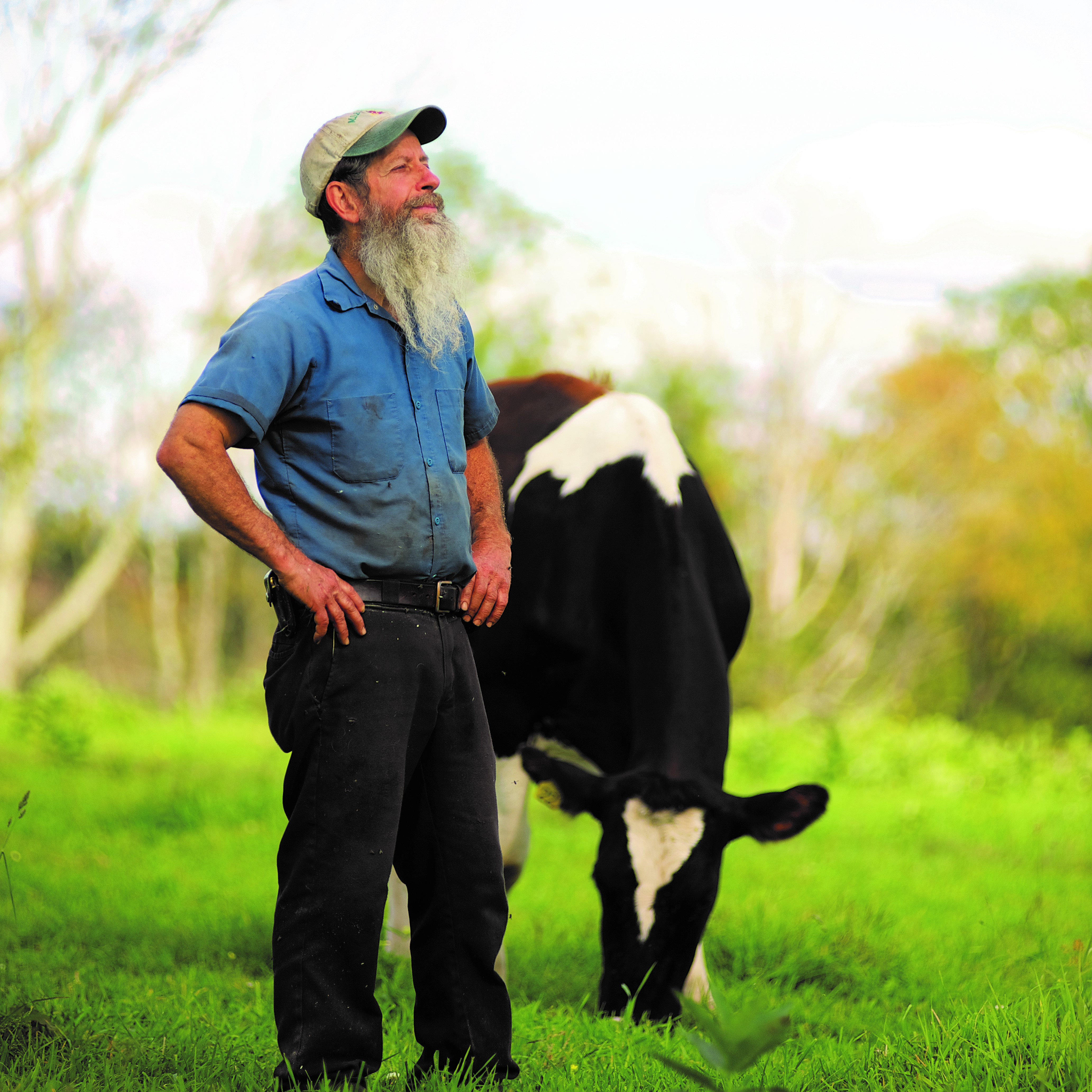
Clean Cut
While Refoel’s plan to transform the Jewish world with his program for teenagers hasn’t yet taken off, the Franklin farmstead has been the venue for another revolution-in-the-making, this one in the field of kashrus. First with his Pelleh Poultry brand of chickens and more recently with his Bethel Creamery all-natural dairy products, Refoel Franklin has developed an almost cultish
following among an unusual cross section of discerning consumers: those who seek the highest standards of kosher slaughter, and those for whom healthful eating and ecological sustainability are paramount.
It was Rabbi Freifeld who first encouraged Refoel to learn shechitah, and his first mentor was a shochet named Reb Leizer Zirkind, a member of the old-time Williamsburg-based Malochim. He taught Refoel how to shecht “fartzeitish,” the old-fashioned European way in which the shochet is the only one holding the bird as he shechts.
When Refoel first purchased the farm, he decided to build it up slowly, so he worked part-time as a shochet at a now-defunct Catskills slaughterhouse called Falls Poultry. There, he met the man who would become his primary mentor and inspiration in shechitah, Reb Yossel Genzler, a Seret-Vizhnitzer talmid chacham whom Refoel calls the “Johnny Appleseed” of shechitah: “He moved around a lot, getting fired often for insisting on doing things the way the Shulchan Aruch says you should, and wherever he went, he taught people how to upgrade their shechitah. He taught me how to work in a factory setting where I’d have to speed up but could still shecht well.”
Under Reb Yossel’s influence, Refoel says,
“I started to get pretty frum about my shechitah and began seeing a lot of problems in the way things were done. I saw there was an opening for me to offer something better.” He quit working at Falls and started shechting about 50 chickens a day, and slowly, customers started coming: one, then another, then a third. “I decided to rehabilitate an old chicken coop on the farm, for which I received state inspection, and I got a small flicking machine for removing feathers. I had a little van and was delivering to a few customers in Monsey, but the financial pressure was immense.
“At the time, people told me ‘don’t do it, you’re a Yankee Doodle. Somebody tried to do that up in Boston and they slashed his tires and broke his windows.’ But I figured I’m so small-time, nobody’s going to bother me. Then, one day, I get a call from a son of the Kashauer Rav, who said to me, ‘We hear you have a new shechitah with certain maalos that we’re looking for in Kashau, and we wanted to visit and see for ourselves.’
“He showed up together with a certain chassidishe rav who was an outspoken kanoi about shechitah and eventually had to leave for Eretz Yisrael for speaking too bluntly about the system then in place. This rav was quiet the entire time but at the end, he pointed to a stainless steel basin where the chickens were draining off after kashering and said to me, ‘How many chickens are in there?’ I said, ‘About 40 or 50.’ He said, ‘Can I buy the whole lot?’ That day I became a real business. Within a week’s time, sales took off exponentially, because if the Kashau community had become customers, all of a sudden lots of people wanted my chickens.”
Pelleh Poultry now produces upward of 7,000 chickens each week, thanks to oldest son and company CEO Eliezer, who has ensured that Pelleh’s rapid growth hasn’t affected its industry-leading kashrus standards. Eliezer was just out of kollel when he joined his father eight years ago, and with no prior experience, he did every job in the company to familiarize himself with the business and figure out how to go from a mom-and-pop shop to an efficient, large-scale operation.
At first, the senior Franklin was opposed to any changes. “But,” Eliezer recalls, “customers were finding dam b’eyn in the chickens, because we were still washing each one by hand. That was fine back when we were producing 50 chickens a day, but when you’re doing 500, the people washing the chickens would get tired. That’s when we realized we needed to automate much of the process, which would actually enhance the high kashrus standards.”
Although the Pelleh plant is now a state-of-the-art facility, with a bar code system and machine wrapped packaging in place of putting chickens in plastic bags, it remains at its core a heimishe venture that caters to those who are willing to pay for quality. Due to the price differential with other brands, most stores don’t carry Pelleh products and the bulk of its sales are through home deliveries.
So what is it that sets a Pelleh pulke apart from the pack? Before answering, Refoel emphasizes that although years ago there were more problems with industrial shechitah, “it’s not like that anymore; now, it’s excellent. There have been constant improvements, because people are getting more educated and demanding something good. Once upon a time, the industry was serving a public that just wanted to be able to call it kosher, but now it really is. Still, there are certain things we can do because we’re smaller and we go slower.”
With Refoel devoting more time to the farm, the main shochet today is Reb Shmiel Menachem Tzig from the nearby Vizhnitzer community in Kiamesha Lake, who, like Refoel, learned shechitah from Reb Yossel Genzler. The shechitah itself, Refoel explains, is slower than at larger, higher-volume facilities. When I joke whether that means they meditate between chickens, Refoel replies, “Something like that, actually. It’s called mesinus halev. Everything, the bedikos, the shechitah, is done b’mesinus halev. Nothing is allowed to distract one’s concentration. And if something would happen like that, we’d change the whole system to prevent it.”
Another major Pelleh plus is that the checking of each chicken’s innards is done while it is lying split open on a table rather than as it goes by on a conveyor belt. But because the conveyor systems used in the industry are made for whole chickens, the Franklins had to custom-design their own equipment to allow for the chickens to be split open before the entire process of inspection, salting and washing takes place.
The farm’s other major product line is organic milk, yogurt, and cheese, and as with the chicken production, his customers are willing to pay a premium for either the superior kashrus or healthfulness he offers. Refoel explains that “with our cows, there’s no chashash of surgeries or needles or anything like that because they are all born here at the farm, so we know their histories.
And since they only graze, rather than eat grain, there’s no need for surgeries. Grain changes the acidity in the stomach, which in turn reduces the population of bacteria that cows need to digest the cellulose in grass. When a cow eats grass that is not fully digestible, it can end up with a twisted abomasum, which requires corrective surgery.
Bethel Creamery milk comes from cows that have been raised on organic feed, and has no additives. Nor is it homogenized, as one look at the thick layer of cream on top will evidence, since according to Refoel, there’s a lot of new research — which the dairy lobby has tried to squelch — on how homogenization makes digestion difficult. He also pasteurizes his milk at the lowest legal temperature, which ensures that it retains most of its enzymes and makes it appropriate for some lactose-intolerant consumers. As for yogurt, Refoel developed his own vegetarian cultures, so he doesn’t have to use the ones that are commercially available.
No Reservations
All of the pathways in Refoel Franklin’s unconventional life — working the land, helping young people, the shechitah — seem traceable back to the influence of one larger-than-life figure: Rav Shlomo Freifeld. But the road that led Refoel to his rebbi was even more
unconventional still. Growing up in Bensonhurst, New York, Bob Franklin had lots of exposure to Judaism, attending Hebrew school and shul. But having a very spiritual side to him, he became deeply disenchanted with what seemed to him a dry, legalistic religion. He wanted to be able to talk to G-d, but not with a book. His mother, who shared his spiritual bent and sense of wonder, kept her kids exposed to nature’s beauty even in the midst of Brooklyn, through the garden she tended and the books she’d give them to read.
It was thus no surprise that Bob chose to spend his college years studying wildlife biology at the University of Montana, specializing in wild canine ethology — the study of the behavior of wolves, coyotes, and foxes. He was rarely in the classroom, instead spending weeks, sometimes months at a time out in the wild doing field research. Once, he recalls, he went three months without seeing or speaking with a human, which he remembers as “the best thing I ever did in my life.” Bob’s family owned land at the foot of the Swan range, right near Glacier National Park at the Canadian border, and he built a little house there, where grizzly bears would frequent his front yard in summer and elk would show up in winter.
From a very young age, Bob had been fascinated by and read voraciously about the lives of American Indians, or as he calls them, Native Americans. At college in Montana, he befriended students from some nearby tribes who were training to become lawyers and go back to defend their people against the “Big Hitler,” i.e., the United States government. This white, Jewish kid from Brooklyn’s knack for languages enabled him to learn Kayna, the dialect of the Blackfoot Indians of north-central Montana, and coupled with his friendships with the Indians on campus, this gave him entr?e to the local reservations. He was intensely interested in hearing the Indian elders reminisce about olden times, telling “stories that could make your ears melt, of soldiers surrounding them and butchering them indiscriminately. One elder, 116 years old, would sit all day and teach and talk about the old times. He’d take five-minute rest breaks by putting his head between his knees and then he’d start up again.”
But even as Bob was getting ever more deeply involved in Indian life, a series of events began slowly redirecting him back to the faith of his fathers. He had spent a great deal of time with a certain group of traditionalist Blackfoot Indians who, when the advent of electricity brought television to their reservation, left to wander up and down the Rockies, hunting and fishing. Many of their beliefs seemed not so far from the little he thought he knew about Judaism.
“But one day,” he says, “there was this ‘purifying ceremony’ in a sweat lodge, which is a hut made from willow branches covered by blankets, and they were saying these prayers that seemed monotheistic. But then, they started rattling around these smooth red stones shaped like bison to which they ascribed supernatural powers, and praying to the spirits. At that moment, I had a very bad, deep-down reaction, because whatever Yiddishkeit I had in me recoiled from what seemed like avodah zarah. I picked up the wall of the sweat lodge and ran away.
“At around the same time, I was living in a log cabin about 27 miles from Kalispell, Montana, and one day, I traveled into town with an Indian friend to see a movie. There were all of about ten people in the theater. All of a sudden the movie starts — and I almost fainted. It was Fiddler on the Roof. There were no Jews in that whole town, but they showed whatever the theater got in the mail. We sat through both showings, as I bawled my eyes out. My friend was firing questions at me about what we were seeing, like the Jewish wedding customs, and I had no idea what to answer.
“The next day, I drove back to Kalispell’s only bookstore and asked, ‘Do you have anything Jewish to read?’ The owner came up with a popular book of Jewish historical fiction that certainly wasn’t anything good from an authentic Jewish perspective, but I devoured all thousand pages. I went to the University of Montana library, and found a Soncino translation of Shas that I started going through backward, beginning with Niddah.”
One of his Indian friends in college was named Tony Horse, whose grandfather had been at the famous 1876 battle at Little Big Horn between Lakota and Cheyenne Indians and General George Custer’s troops. In the summer of 1971, Tony invited Bob to join him and his mother and five brothers at a big yearly gathering of many different Plains Indians tribes consisting of over 10,000 teepees, pup tents, and trailers alongside the Little Big Horn River, just below the battlefield where Custer’s Last Stand had taken place. Bob was probably the only white man present at this four-day encampment.
Tony’s elderly mother was named Elva One Feather, and when she invited Bob to come back home with her family, he eagerly accepted, seeing this as his chance to truly integrate into authentic Native American society. Home was a Sioux reservation in Oglala, South Dakota, and Bob’s first glimpse at Elva One Feather’s “community” left him reeling in shock. It was made up of old rusting car bodies, tar paper shacks and tin sheds; her “house” was a 1942 Ford car body with one seat removed and a hole cut in the roof where she burned cow dung for fuel. People were starving and children were running about unclothed, their bellies swollen from hunger.
Elva’s sons explained to Bob that they lived this way because they didn’t accept welfare, which would have required them to send their kids to government schools where they’d have to cut their hair and stop speaking their own language. They preferred to die as Indians rather than to become “apples,” their term for people who were “red” on the outside but “white” on the inside.
Elva had some knowledge of the Bible from the year she had spent as a child at an out-of-state Catholic school. She peppered Bob with questions about Judaism, but he didn’t have many answers. Then one day she said to him, “You know, if you were a Christian, I would say you should stay here, because those guys think you can kill G-d; you can’t kill G-d. But you and us, we’re the same religion. Our men go sometimes to a high place and fast for four or five days and pray to get a vision of how to live their lives and connect to our old ways. And that’s what your Holy White Rock Man did; he went up into the rock and didn’t eat or drink until G-d revealed His vision to him.” She was talking about Moshe Rabbeinu, who stood b’nikras hatzur. “So what do you need us for? You got it already.”
The Hunt
This was a watershed for Bob, who decided he needed to spend time really getting to understand Judaism, “because I had to be realistic: I was Jewish, not Indian. Over the next few years, I was in graduate school, for which I traveled widely and did fascinating field research. I did one study of the nesting habits of bald eagles, another on coyote predation on domestic sheep in Montana, New Mexico, and North Dakota, and a third on the effects of wolf predation on caribou migration in Alaska’s Kuskokwim River Valley and in British Columbia. But all the while, I was reading about Jewish topics.
“Then, in 1975, I decided to take time off to focus on Judaism, so I went to my cabin and spent a year by myself. I started reading widely and worked on my rudimentary Hebrew, but eventually I felt I needed to study with living teachers because there’s just so much one can get from books. I had gotten hold of this New Age-type volume called The Jewish Catalogue, which had a whole list of rabbis from whom to learn about Judaism, and I made my way to New York in the fall of 1976 to check some of them out.”
Using his brother’s Tribeca artist’s loft as his base, Bob ventured into the Jewish outreach scene, then at its height, with thousands of young Jews awakening to their roots and exploring various forms of Jewish expression. He encountered a number of colorful and charismatic figures, but, he says, while “it was fun, the music was great and the stories were fabulous, I knew it wasn’t authentic, it didn’t ring true. It wasn’t what I was looking for.
“One of the big questions I had was about the Torah’s attitude toward hunting. Out west, I had lived from hunting deer, elk, bighorn sheep, moose, you name it. For me, as for the Native Americans, it was a spiritual experience. And here I was reading Chumash and there are many seeming references to hunting. Of course, that’s not really what was meant; the pesukim are talking about catching animals alive and then shechting them. I had broached the topic with one rabbi, but he was completely dismissive, almost indignant that I had even asked the question.”
Then, as Bob was getting ready to pack up and go back to Montana, he met an acquaintance who said to him, “If you’re looking for real Yiddishkeit, you gotta go to Rabbi Freifeld,” and gave him his phone number.
He went back to his brother’s place and called. Rabbi Freifeld himself answered the phone, and when Bob said he wanted to talk about Judaism, he heard Rav Shlomo’s deep baritone on the other end. “Come on over.”
He drove straight out to Far Rockaway, and as he entered the Freifeld home at 707 Bolton Road, he encountered a scene he’ll never forget: “Fourteen-year-old Avrum Mordche, with long peyos and a little beard coming in, was lying on the couch reading Mark Twain. Over in the corner was daughter Penina at the piano, playing a Beethoven concerto. Then Rav Shlomo came to the door of his office, this massive, authentic man, the first person I’d seen who looked really, truly authentic, so I just warmed up right away.
“I came into his beautiful office, lined with seforim on all four walls along with a couple pictures, the Imrei Emes, the Sheim MiShmuel, and Rav Shlomo sat me down and said, ‘So, where you from?’
“ ‘Montana.’
“ ‘Montana?!’ he bellowed. ‘Whaddaya doing in Montana?’
“I braced for what I expected — based on past experience — would be the response to my next words. ‘I hunt.’
“ ‘You hunt? Whaddaya hunt?’ In an instant, he was full of questions for me — How? When? All of a sudden, I was the rebbi, and I started explaining about how to tell if the tracks are fresh, how to know if the game population is high enough to harvest some of them, about the smell of the musk glands, how to cut it up. Then he said to me, ‘Anybody that can hunt in Montana, his father doesn’t have to worry about him making a living. Now, you wanna join the Hungarian Navy? In the Hungarian Navy, they throw you in the water, and if you can swim, you’re in. Be in yeshivah tomorrow morning nine o’clock.’
“I was there at nine, and there was a big crowd there for a bris, but I had no idea what was going on. Looking back, it was so smart of him that he didn’t have me come for davening. This was how he worked, he never told you put on tzitzis, do this, do that; instead, loz es kumen tzeitlich [let it come in its time]. Suddenly, a tall fellow, Avraham Halpern, approached me. ‘You’re Franklin?’ ‘Yeah.’ ‘Come with me.’ He took me by the arm and pulled me through the crowd, placing me next to the kisei shel Eliyahu, where I could watch the bris, for which Rav Shlomo was the sandek. Rav Shlomo wanted me to see dam shel kedushah; it was his idea, after all, that I should become a shochet.”
Personal Ecology
Refoel joined the yeshivah and spent the winter in the beis medrash, round the clock. “I had to make up for lost ground. Rebbi told me right away from the start, ‘no English, no crutches,’ so I just plowed away, a finger on the Gemara, a finger on the Rashi. And it paid off: In my second year, he put me into the top shiur, and at night I’d learn with Rav Naftali Jaeger in his house. If you listen to any of the CDs they’ve made of Rav Shlomo’s shmuessen, you’ll hear my name mentioned a lot of times because I was constantly asking, and he liked my questions.
“I was one of those guys who was there five o’clock in the morning with him in the little coffee nook at the back of his kitchen. That was the place to be, with Dovid Sitnick and Shmuel Brazil and Heshy Markovits and Moshe Dov Stein, and the coffee and the stories and the divrei Torah and the jokes…”
Rebbetzin Freifeld, Refoel says, “was a malach. The very first Shabbos, I made the mistake of thinking I’d be staying with the Freifelds for Shabbos rather than at the yeshivah, and when I came to their door on Friday afternoon, Rav Shlomo was taken aback. But the Rebbetzin chapped right away that I had misunderstood and immediately took me upstairs and gave me a room and made me feel at home.”
Despite his integration into frum life, Refoel remained deeply affected by his experiences with American Indian culture. “I still thought there was so much truth by some of the Native Americans out there, and I still think there is. It’s not Torah, but there’s a lot there that’s just… solid stuff. I would talk to Rebbi about this and he would listen. This was part of his gadlus; he loved people so much that he really wanted to hear what they had to say. If it was about business, he listened. If it was about history or philosophy, he was there. And it wasn’t like a subterfuge to chap you, it was genuine.”
Refoel’s yeshivah experience would have been idyllic, except for the fact that he couldn’t stand city living. He would escape to go bird-watching in the nearby Jamaica Bay Wildlife Preserve’s thousands of acres of swampland. During the spring, he would point out to fellow students the migrational patterns of the birds soaring above, but nobody cared. A committed, educated environmentalist, accustomed to pristine water and air, he was shocked by the disposable tablecloths and the pollution. He’d often complain about these things to Rav Shlomo, and once, Rav Shlomo said something to him in Yiddish that helped him a lot, “Refoel, Yidden hoben gelebt in Poilen acht hundert yohr, efsher mehr. Mit di aniyus, di pogromen — s’iz a neis vos mihr hoben gebliben Yidden [Jews lived in Poland for 800 years, maybe more. With the poverty and the pogroms, it’s a miracle we remained Jews]. We should be perfect also?”
But by the time Pesach arrived, Refoel desperately needed a break, and headed back out to his Montana cabin at the foot of the Rockies. This scenario repeated itself every year Refoel was in Sh’or Yoshuv. He’d be in yeshivah from Succos through Pesach, working hard in learning, and then go back to Montana for the next half-year. Each year, he’d tell himself he wasn’t coming back, but every time he found another excuse to show up after Succos.
For Refoel Franklin, life has been a long and winding road, as some popular lyrics from his Sh’or Yoshuv days would have it, leading from Brooklyn to places like Montana, Alaska, and northern Canada, then back to New York and now, the Catskills. But 24 years this Succos after Rav Shlomo’s passing, Refoel still credits his rebbi with helping a young man to see his entry into the world of Torah not as a renunciation of his earlier stops along the way, but as a means to elevate the values he has always held dear. “During one of the shmuessen, I asked him why Jews aren’t ecologists. He said, ‘Refoel, I want to tell you what ecology is. HaKadosh Baruch Hu created the world, and it says a very interesting thing: Vayechulu haShamayim v’ha’aretz v’chol tzeva’am. Rashi asks what was missing until now and he answers that the world was missing Shabbos. Everything had been created, but what was missing was the neshamah of it all — Shabbos — which ties all of creation together, just as the neshamah does for the guf. Why is a talmid chacham called ‘Shabbos’? Because he understands how everything in creation is related, he understands what is the pnimiyus, the life force, of everything. So ideally, we are the world’s ecologists.’
“Rav Shlomo paused, and then he said, ‘And tell me, Refoel, your colleagues who you used to work with — what’s with their personal ecology?’ This just blew me away, because I knew what he was getting at. I had, for example, worked with someone who’s world renowned, writes a lot for National Geographic, a brilliant wildlife researcher — and the guy was an animal.”
For Refoel, that exchange was “a tremendous limud and a huge leap into genuine Judaism.” These many years after that illuminating moment, Refoel continues to believe that his love of Hashem’s world and the creatures within it, first nurtured among a foreign people, is an authentic expression of Yiddishkeit, one he has made uniquely his own.
(Originally featured in Mishpacha Issue 530)
Oops! We could not locate your form.

